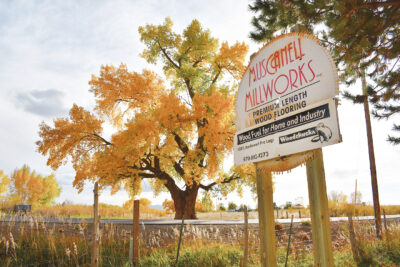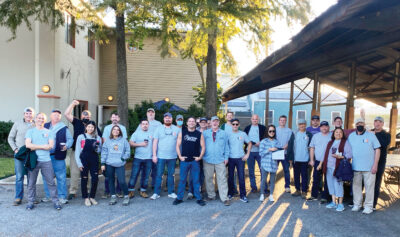If you’ve attended industry events in the last six months, you might have heard about Sustainable Hardwood Certification (SHC). This program is an effort from the American Hardwood Export Council to create a cost-effective solution to verify the sustainability of American Hardwoods and maximize market opportunities for our Hardwood products. The SHC website is now live at www.shc-cert.org to explain why the new certification system is being developed and how it will operate. For this program to get up and running, we need to show global stakeholders that the U.S. industry is behind this project and sees the need for a risk-based jurisdictional certification program. To show this support we need companies throughout our industry to sign the Statement of Support on www.shc-cert.org. We are not seeking additional funding at this time and signing the Statement of Support comes with no financial obligations. We are asking all Hardwood companies, AHEC members or not, to take a look at what this program will do and sign the Statement of Support to help us create this cost-effective certification program.
SHC draws on some of the world’s best national forest inventory and forest owners survey data compiled regularly by the U.S. Forest Service. We know from this data exactly how much Hardwood of each species is growing, and how much is harvested in each county across the United States. It also draws on high-quality State Forest and Wildlife Action Plans required by Federal law to be prepared and implemented for all U.S. states. In this way, SHC will provide a robust and credible assurance of sustainable forestry which is zero cost for individual forest operators and minimal cost to individual mills. For the first time, it will allow certification at scale in regions where Hardwood supply is from vast numbers of small private family forests, where owners harvest once in a generation, practice very low intensity management, and are typically less interested in commercial timber demand than in other forest values. These operational procedures are inherently low risk and sustainable, but are not captured by existing certification frameworks.
The SHC builds directly on the Seneca Creek reports commissioned by AHEC in 2007 and 2017 which demonstrated a negligible risk of U.S. Hardwood being derived from an illegal or unsustainable source at a national level. SHC improves on this risk-based approach from the Seneca Creek reports by providing even more in-depth data to a jurisdictional level. SHC includes a standard for jurisdictional risk assessment and a standard for chain of custody against which Hardwood logs, sawn wood and mill products sourced from small-scale low intensity harvest operations in demonstrably low-risk states can be certified. This program aims to provide industry-wide accepted certification that will match the increasingly strict requirements seen in Europe and around the world over the last few years. These standards will be reviewed by the SHC Standards Endorsement Body, which will be chaired by an independent expert with long experience of forest certification along with other experts in certification, forestry and the environment, and representatives of stakeholders with an interest in Hardwood forest management. This process is currently underway, and once the standards have been endorsed, AHEC will commission risk assessments covering all U.S. Hardwood producing states.
Through the www.shc-cert.org website, all Hardwood producers, exporters, and their suppliers and customers are encouraged to sign a Statement of Support for the SHC as a mechanism for targeted certification of Hardwoods from non-industrial and low-intensity managed forests. Hardwood sector support for SHC will allow the sector to better exploit new opportunities for environmentally friendly zero-carbon products. SHC also responds to regulatory requirements for low-risk forest products now being implemented in a widening range of export markets including Australia, the EU, Indonesia, Japan, South Korea, Switzerland, Vietnam, and the UK. There are signs that even China will move towards similar regulation of timber trade, given direct government support for PEFC certification of state forests and with passage of the 2019 Forest Law which, in Article 65, imposes a prohibition on any trade in wood knowingly derived from sources that are either illegal or linked to deforestation. Internal benchmarking of certification systems both internally by AHEC and by other agencies such as the European Commission suggest that systems like SHC that show that wood originates from specific jurisdictions independently assessed as having robust forest governance and stable or expanding forests are the best assurance of legal and sustainable timber supply.
Challenges posed by new EU deforestation regulation
While SHC is being developed to facilitate worldwide market development of American Hardwoods, an immediate concern is to assist exporters to comply with the new EU anti-deforestation law. The target start date for implementation of this law by larger enterprises is January 1st, 2024, with smaller enterprises following 12 months later on January 1st, 2025. The situation in the EU illustrates well the scale of both the export market opportunity, and the regulatory threat, for American Hardwoods due to greater market focus on zero-carbon and zero-deforestation products.
The downside for American Hardwoods in the draft new EU deforestation law comes from the mechanism proposed by which traders of wood and other regulated commodities would have to demonstrate low risk status. The idea is that anyone placing consignments of wood and other forest-risk commodities on the EU market would have to provide, with each consignment, the “geolocation data” for all “plots of land” from which it derived. “Plots of land” are defined narrowly as individual “real estate” properties. This data would be required irrespective of the underlying level of risk in the supply country and region. The draft law recognizes that existing certification systems would be a useful tool to demonstrate compliance, but EU law makers seem disinclined to accept any form of volume credit procedure that largely underpin certification systems like FSC and PEFC.
AHEC believes the geolocation issue can be easily resolved if the definition of “plot of land” is amended from “real estate property” to instead refer to a state or jurisdiction. We have extensive data to show the low risk for products sourced from low intensity harvesting of natural forests by small landholders across the United States and can provide this data on a jurisdictional level through the SHC program. This would level the playing field with larger industrial and state forest operations for which an individual “real estate property” may extend to millions of hectares and will often comprise much less diverse forests.
There are signs that the EU may be willing to compromise on this issue. In his final report to the European Parliament on the regulation, the chair of the Environment Committee acknowledges that the geolocation requirement “poses the biggest challenges for the implementation on the ground” and highlights the specific obstacles for smallholders.
Therefore, it seems likely the EU will be receptive to a constructive proposal from the U.S. Hardwood sector to satisfy their requirements for legal and deforestation-free timber through an innovative certification system which identifies the source of timber to specific identifiable low-risk jurisdictions. If this approach is recognized by the EU, which has the toughest environmental laws, there’s every prospect that it will be accepted in other markets implementing similar regulations. In the long run, a single program for sustainability certification, designed specifically to accommodate the needs of the U.S. Hardwood industry and widely promoted and accepted in world markets, should contribute to reduced verification costs and enhanced reputation. To help get the process moving, please sign the SHC Statement of Support on www.shc-cert.org.








